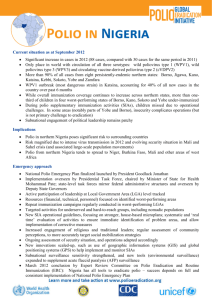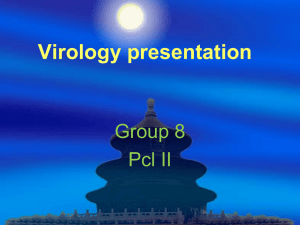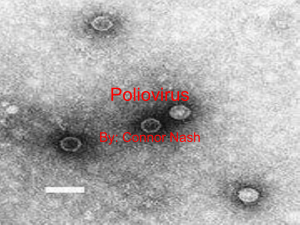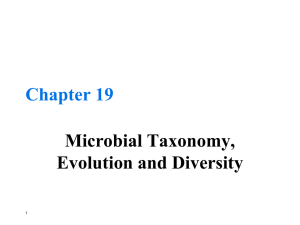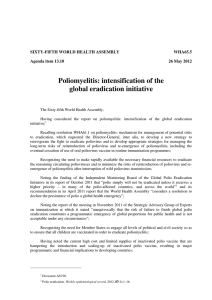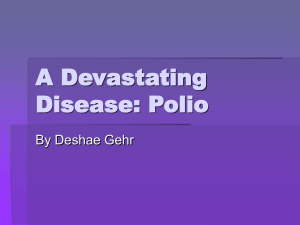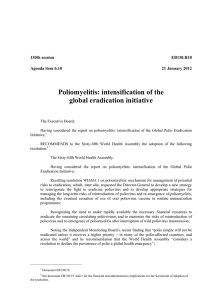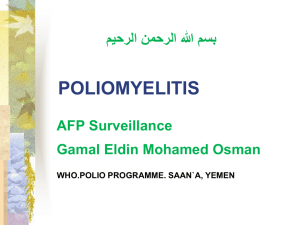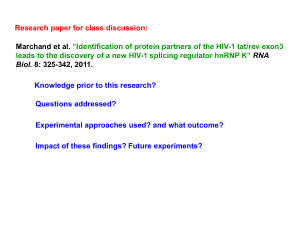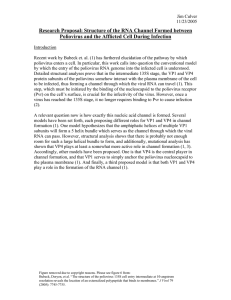09 Chapter 36 Picornaviruses
advertisement
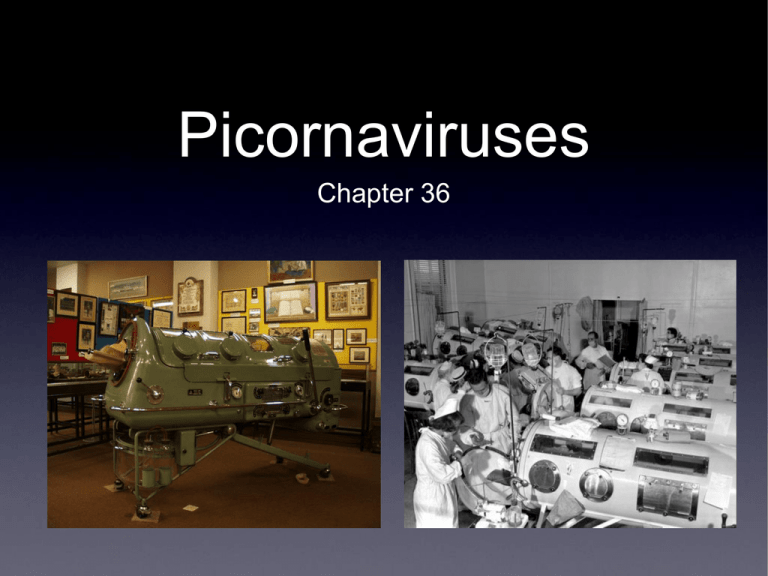
Picornaviruses Chapter 36 Properties • Structure and composition 30 nm, icosahedral plus-strand RNA, 7.2-8.4 kb • • • • Ten genes, eleven proteins (poliovirus) • • • RNA is polyadenylated • • VP1, VP2, VP3, VP4 structural proteins • VP4 interacts with viral RNA 2A, 2B, 2C proteases 3A, 3B, 3C, 3D RNA replication Nonenveloped Cytoplasmic replication Properties • Classification Family Picornaviridae Genera • • • • • • • • Enterovirus Rhinovirus Hepatovirus Parechovirus Aphthovirus Cardiovirus • Replication Overview Replication is cytoplasmic (poliovirus) Attachment to poliovirus receptor (PVR; CD155) Internalization by receptor-mediated endocytosis • • • • • • • • Binding to PVR destabilizes poliovirus’ structure RNA released into cytoplasm • It’s unclear how the RNA is released, but evidence suggests that VP4 is injected into the cytoplasm through the endosome membrane, taking the RNA with it The RNA is bound by free ribosomes and a single polypeptide is synthesized This polypeptide is termed the polyprotein It has intrinsic protease activity and undergoes autocleavage It also cleaves the cellular eIF4G, disabling cellular translation Viral RNA polymerase synthesizes minus strand RNA, then plus strand Virus assembly occurs When the cell dies, progeny virus is released • • • • Pathogenesis of Polio Poliovirus Principally an infection of the gastrointestinal tract • • • Before the vaccine, swimming pools were often closed during poliovirus outbreaks Clinical spectrum Abortive poliomyelitis • • • • • • • Most common Fever, malaise, headache, vomiting, etc. Resolves in about a week Nonparalytic poliomyelitis (an aseptic meningitis) • • Similar symptoms, but also back pain Paralysis can occur in a small percentage of cases Paralytic poliomyelitis • • • Motor neuron damage Mostly flaccid paralysis, but spasms in some Recovery within 6 months, otherwise permanent Progressive postpoliomyelitis muscle atrophy (postpolio syndrome) • • Can appear decades after polio infection Not caused by viral recrudescence, but probably because of previous Polio • • • • Laboratory diagnosis Cell culture was routinely used Since polio is not a disease of the West, no new diagnostic methods have been developed Immunity VP1 is principal target of neutralizing antibodies Provides life-long immunity Global eradication Humans are only reservoir Should be the second infectious disease eradicated Target of 2009 Epidemiology Oral-fecal route Swimming pools Close contact • • • • • • • • • • Polio • Prevention and control Vaccination is the principal means Two vaccines available Salk - inactivated, percutaneous inoculation (IPV) Sabin - live attenuated trivalent, oral administration (OPV) • • • • • • • • One of the strains has a known propensity for reversion to pathogenicity Can cause polio in post-vaccination exposures (i.e., not the vaccinated person) In nations where polio has been eradicated, children are given the Salk vaccine Other nations use the Sabin vaccine • • Coxsakieviruses Properties Two groups; A and B 29 serotypes Newborn mice are highly susceptible Pathogenesis Neurologic • • • • • • • • • An aseptic meningitis A7 and A9 most common causes Polio-like, but paralysis is rare Full recovery Skin and mucosa • • Herpangina (severe pharyngitis) • A2-A6, 8, 10 most common Hand-foot-and-mouth disease • • • Blisters on tissues Usually A16 Resolves without complications • Coxsakieviruses Pathogenesis (cont.) Cardiac and muscular (Group B) Pleurodynia • • • • • • • Chest pains, 1-2 weeks Self resolving Myocarditis • • Inflammation of the heart Can be fatal in newborns Survivors can have permanent heart damage • Others • • • • Acute hemorrhagic conjunctivitis Respiratory infections (“colds”) GI infections Diabetes? Laboratory diagnosis • • • Virus isolation Serology PCR Echoviruses/Rhinoviruses • • Echoviruses Enteric cytopathogenic human orphan viruses 30+ serotypes GI and cold-like infections Rhinoviruses Common cold viruses More than 100 serotypes known Immunity is not cross protective • • • • • • Foot and Mouth Disease • • • • • Major problem in domesticated livestock Highly contagious Mortality can reach 70% Immunity is short-lived Some cattle can remain persistently-infected for months General response: cull the herds Not generally found in the United States • •
